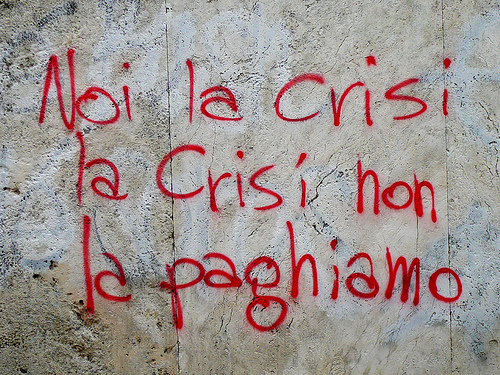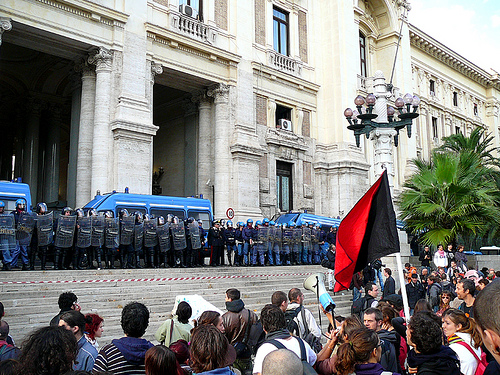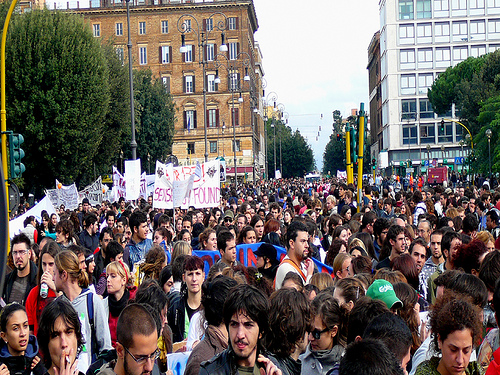We Won't Pay for Your Crisis: Italian Struggles Against Education Reform
Berlusconi's stinging cuts to state education have encountered strong opposition across Italy. With the credit crunch upending the wider neoliberal project, Paolo Do and Gigi Roggero consider the potential for an expansion of the struggle
In the summer of 2008, the Berlusconi government approved a financial bill that, at a time of economic crisis, introduced heavy cuts in the funding of the Italian public education system. The three tiers of public education have been hit by cuts that seem to amount to a total dismantlement of the system. Following a draft initiated by the left, and continued by the right in a less scrupulous fashion, Italy's public education system has spent the last ten years in deep crisis. As the years pass, reorganisation has come to look increasingly like dismantlement.
It's against this process that primary and secondary schools, as well as university workers, started their protest in September 2008. Students, researchers, precarious teachers, PhD students, and schoolchildren with their parents occupied schools for several weeks, stopping lessons and blocking the university. The protests focused on the cut in full-time teaching positions and addressed the topic of worker time and affective labour, of reproductive labour. Thousands of students protested in the streets and squares under the slogan ‘We won't pay for your crisis'.

Occupy the university and block the city: this has been the call from one of the biggest Italian movements in recent years, taking inspiration from the protests in France which, through Manif Sauvage (Savage Demonstration), continuously blocked and paralysed French cities for at least a month in order to obtain the suspension of CPE law. For weeks, university lessons took place in squares, streets and stations. Thousands of student demonstrators confronted the police, blocking metropolitan activity and turning cities into unpredictable spaces. The protests understood how the metropolis is not only as a spatial condition, but also an articulation of a new form of exploitation and command, and a new condition and possibility for social conflict.
The movement did not only occur in Italy. There were many demonstrations in Italian consulates throughout Europe: in Berlin, Madrid, Barcelona, Paris, London and Copenhagen, Erasmus students as well as precarious researchers tried to establish themselves as activist brigades in the struggle to turn Europe itself into the real field of conflict.
Calls for a new form of welfare to sustain direct and indirect income, as well as a new monetary form for students, have placed this protest beyond the traditional boundaries of the student's movement. Even the traditional figure of the individual student has changed within the productive metropolis. In theatres all over Italy, students and researchers have also been demanding free access to knowledge, as well as free culture. This multiplicity of practice reveals the true diversity of the movement known as Anomalous Wave. Certainly, a wave has erupted in a political context in which the right has never been so strong and the left no longer exists. This wave has been able to invent a new form of mass social conflict.
The Movement within the Double Crisis
We are facing a double crisis: one is the global economic crisis, and the other is the crisis of the university in the modern era. The first is clear for all to see, while the second one has been going through a long process of transformation. Bill Readings wrote about this process in his book The University in Ruins (1997). The Italian protest movement is trying to identify possibilities within this double crisis in order to transform both the university system and knowledge production, and to raise an autonomous university from the ruins. We can point to at least four political and analytical aspects of the crisis that are of particular relevance to the movement against the changes to the university system, changes which are part of a broader global trend, assuming different forms depending on the context.
First is the trend towards corporatisation. In Italy this is paradoxically combined with a sort of ‘feudal power' in the state university system, but there is no contradiction here. Feudal power is the peculiarly Italian interpretation of the corporatisation trend. When we talk about corporatisation we need to be clear that it doesn't mean simply the dominance of private funds in the public university, or its juridical status. It means that the university itself must become a corporation in order to compete in the education and knowledge market, basing decisions on calculated cost-benefit analysis, profit logic, and so on. In other words, the modern university goes beyond the traditional dialectic between private and public. The mobilisation against the corporatisation of the university cannot be based on a defence of the public model, which has been thrown into crisis not only by neoliberal capital, but also by the movement itself. ‘We won't pay for your crisis' means we won't pay for the public university crisis. The opposition to corporatisation poses the problem of how to escape the choice between public and private, state and corporation.

Image: Ministerio Educacion, Rome, 30 October 2008
The second aspect arising from the crisis concerns the centrality of knowledge production, both in contemporary capitalist accumulation, as well as around struggles. The classical mantra of the left, ‘knowledge is not a commodity', is no longer appropriate. On the contrary, knowledge is a central commodity in the contemporary productive system. There is a political economy of knowledge imposed through artificial measures, such as the credit system, the intellectual property system, the system of performance evaluation, the reference economy, and so on. In other words, knowledge production exceeds the classical measure of the production of tangible goods. The so-called meritocracy system creates a hierarchy within education and labour markets and is not concerned with knowledge as a qualification. Instead, it results in a dis-qualification of knowledge, that is, a process of lowering the value of the workforce. Déclassement has been one of the central topics of student struggles all over the world in recent years, and the same is true of the Italian movement. Without being against evaluation in principle, it is essential that we disconnect the measure and the evaluation, meritocracy and quality of knowledge. A meritocratic system impedes quality of knowledge because it aims to create an artificial value in order to capture the collective power of cognitive labour. In other words, our task is to experiment with an evaluation process directly related to living knowledge cooperation. We could call it self-evaluation, based on the fact that knowledge production is definitely out of measure.
Within this context of the centrality of knowledge production, we have arrived at the third aspect: the rise of a new figure of the student. No longer part of a workforce in training, the student is already a worker, a producer of knowledge. Through ‘lifelong learning', as the process is known in the mainstream, the student occupies a position within both the education market and the labour market. The slogan ‘We won't pay for your crisis' brings into immediate focus the question of the relationship between labour and production. It should be seen in light of the shift that has taken place in the university selection process from exclusion to differential inclusion. The result is that, in the permanent accreditation system, the value of the student-worker does not depend so much on whether a person attended a higher education institution or not, but on what institution he or she attended. So the value of the degree is related not necessarily to quality of knowledge but to the position (that is, the artificial value) of the university in the hierarchy of the education market, determined by the prestige of the institution (its brand) and the possibility of accumulating advantageous relationships, measured as human and social capital. Neither does the increase of fees indicate a return to classical exclusion mechanisms, because enrolments increase as well, but through the debt system, which constitutes another selective filter used to regulate the value of the workforce. It is a lowering of the wage, often before a wage has been earned. Since education and knowledge are incompressible social needs, the financialisation of welfare is a means of realising these needs on an individual basis. But it is also symptomatic of the permanent fragility of the system, the endless accumulation of debt being one of the causes of the global economic crisis. In Italy the government and its think tank are therefore trying to import a model that is already engulfed in crisis.
An Anomalous Wave is Haunting Europe
Finally, the last aspect points to the central political problem. If the modern university has transgressed the traditional dialectic between public and private, as well as inclusion and exclusion, the alternative to the crisis is not a return to the public system, or inclusion within a neoliberal system. The struggles indicate that what is at stake is the autonomy of living knowledge and the construction of common institutions; the autonomous organisation of social cooperation. Here we need to be clear about what we mean by ‘common' or ‘the commons'. The commons do not exist in a void. They are continuously subject to possible capture by capital. Today capitalist value production is based not so much on the organisation of social cooperation, but on the capture of the commons. On the other hand, the commons themselves are characterised by social cooperation and living knowledge production. It is this duality of cooperation and struggle, the relationship between singularity and multiplicity, within and against capitalist production, which defines the commons. The double crisis involves the attempt by the capitalist system to continuously block the power of living knowledge and social cooperation in order to control it, while common institutions constitute both the breaking of this attempt and its alternative, based on autonomous organisation of productive forces.
Common institutions indicate a new temporality. Many workers in precarious positions talk about the absence of any future. But traditionally the future has been a normative dimension of the present, in order to control and to defer the radical dimensions of social movements, and to consolidate the role of traditional parties and unions. Common institutions are the reversal of this absence of the future in the fullness and richness of the present. Since they are based on the collective organisation of knowledge production, common institutions are continuously open to their subversion.

Image: Demonstration in Rome, 30 October 2008
This is the meaning of ‘self-reform' within the university movement in Italy. It is not a proposal addressed to the government or some parties, and it does not allude to a reformist practice aimed at softening radical issues. On the contrary, it involves the organisation around radical issues in order to create autonomy, not in some far away future, but right now. It is the consolidation of our power base in order to increase the level of conflict and transformation.
In recent years we have witnessed many conflicts all around Europe, from Spain, Denmark and France, to Greece and Italy. Together, they constitute resistance to the Bologna Process, which is the project to ‘harmonise' reforms throughout the EU and create a common European approach to higher education. These struggles share the same goals of autonomy and conflict in knowledge production. Now we must take another step forward. We have to re-think the European model and continue to build a Counter-Bologna Process, through the transnational organisation of the autonomous university; a university without borders.
Paulo Do and Gigi Roggero are research students involved in the edu-fectory project. For more information on Anomalous Wave go to http://www.edu-factory.org
Mute Books Orders
For Mute Books distribution contact Anagram Books
contact@anagrambooks.com
For online purchases visit anagrambooks.com






